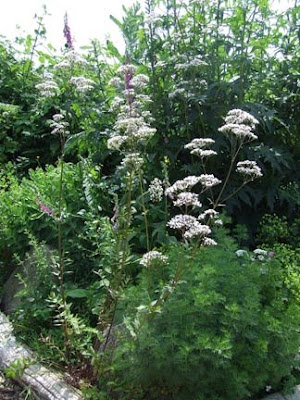
Campanulas, mallow, and other flowers I don't really like grow in the garden behind our house and I am always trying to pull them up because I want the garden to be of MY creation, instead of something I inherited from someone else. However many I pull, they still come up year after year, spreading their seeds far and wide. On Saturday I saw a megachilid bee inside the bell of one of the campanulas happily covered in its white pollen, so my heart was moved to think differently. Any flower that has a morphology that protects its pollen and nectar from dilution by the rain is very important in Vancouver. The next thing you know I saw my first leaf cutter bee of the year looking in the same flowers and then a honey bee, so maybe there is a reason all those cottage gardens have a good stand of campanula in them. Today I saw two other kinds of native bees, including one that looked like a tiny wasp with pollen pockets and one similar to a mason bee, but smaller, with a bright blue abdomen. One small bee even knocked a larger bee out of a bell, roller-derby style. The campanulas will stay. In fact, now I wish I had not pulled any out at all.

I have tried to grow sweet peas in this garden, as they remind me so much of mom's garden back home in Saskatchewan where she grows them chock a block in candy store colours, but I haven't had much luck. This garden remains a Vancouver garden, inherited from the women who used to own the house, one of whom was driven from it by her abusive husband. Did she plant the Canterbury bells, having a better knowledge of what would thrive here in this ecosystem? Did the garden give her some pleasure and solace while she raised her children here under the shadow of her violent husband?

The other woman was the mistress who came into the house and stayed, having built up a barrier between her and the crazy man so that she could survive here as long as he kept to his side of the house. She nourished the roses and drank beer and watched tv on an outdoor balcony while admiring them. After she sold the house to us and moved she found out that her lover's wife was still alive and was owed half the proceeds. This didn't leave her enough to retire on so it is suspected she committed suicide. This is all cobbled together from rumor and hearsay, but it's part of the mythology of our house and garden. Part of the campanulas, rugosas and mallow.

Meanwhile, the lush life of the garden grows on. The strawberries are starting to blush, and the sunflowers that haven't been farmed out to aphids by tiny ants are almost blooming.

Those tiny ants are a real problem this year. I see their aphids are also destroying my bitter melon plants and the ants are getting into the beehive. I read about putting Tanglefoot on the structure that holds up the hive as a protective barrier, so I felt this was what I needed to do. In fact I was feeling so much anxiety about ants getting into the hive I dreamed that I got Tanglefoot in my hair while trying to apply it. It's darned sticky and it smells awful. I hope that once it's exposed to air the odor will dissipate. I didn't put much down under the front of the hive because I didn't want bees getting stuck in it, but the ants are no longer crawling up the side of the hive and the bees seem to be ignoring it for now.
I also saw a honey bee with its pollen pockets absolutely full of black pollen wallowing around in my neighbor's giant boudoir poppies so its no wonder we see black pollen packed into our hive.

 I just love this garden with its jewel toned flowers. It's a good grouping of plants for a bee garden, especially at this time of the year. It's about a block west of Burrard along the railway track.
I just love this garden with its jewel toned flowers. It's a good grouping of plants for a bee garden, especially at this time of the year. It's about a block west of Burrard along the railway track. What do we have? Mallow, cornlflowers, poppies,
What do we have? Mallow, cornlflowers, poppies,

 lychnis (not really a bee plant),
lychnis (not really a bee plant),
 lemon balm,
lemon balm, and I'm not sure what the pink flowers are--maybe a geranium.
and I'm not sure what the pink flowers are--maybe a geranium.











































